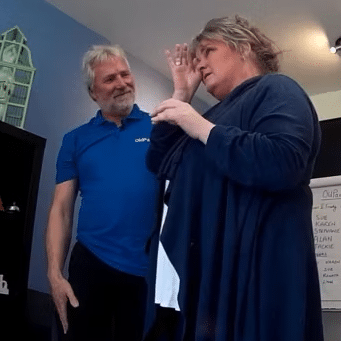OldPain2Go®
Questions and Answers
Please note: This does not constitute medical advice nor is it a substitute for it. You must have consulted a medical professional who had prescribed or advised pain relief. An OldPain2Go Pain Review Session will help you access the part of your mind that deals with your own healing processes and ask for it to review your pain messages. It is not a treatment, it is a non-medical intervention of self work.
These are the typical questions we are asked, if you have one that isn't answered please ask.
For your convenience, and to keep it condensed on the page, the answers are revealed when you click the link.

It is common for a client to have tears of joy on realising they are no longer in pain.
Answer. All results are individual and only relate to the person giving feedback. We have put together a page of OldPain2Go® Anecdotal Result Data where you can see the in-house analysis of 216 feedback forms from volunteers at events, who recorded their own personal experiences and perceptions of changes of pain levels. There is also a link to a substantial amount of Client Testimonial Videos.
Answer. I have trained Doctors, Psychologists, Physiotherapists and Neurologists to be Practitioners in OldPain2Go®. These are the ones open minded enough to try new things and expand their experience.
Answer. Yes it can with a client who is positively wanting to be pain-free.
Answer. Your pain is unique to you and so is your perception of its level. At the end of a review session you may have a change in that perception to record one of three things: Zero Pain, Reduced Pain or, No Change.
Answer. The review may bring about changes regardless of the original cause, providing there isn't still a need for it to be retained at that level. If there is still a medical reason to keep the pain then your unconscious will not fully release it.
No. Pain is a message that once it has alerted you to the problem, and you have done all you can, it is usually no longer needed. Think of a fire alarm, once the fire is out, the alarm bell gets switched off as the alarm is reset. Making it alert again for new fires once the initial fire is out, even if it has caused damage! Our pain is usually noticeably lower as we start to heal so that we can notice a pain message indicating if it isn't healing.
Answer. Yes, it may. Just think about this for a moment, if you are prescribed strong pain tablets or injections that is the medical profession saying that the pain is not necessary! Pain killers do not stop the pain message being sent out they simply interfere with it reaching the part of the body where it is intended to indicate a problem.
Answer. Yes, it may. The old pain message has done its job and alerted you and the medical profession to the problem. If that old pain message was no longer perceivable it will allow new pain to arrive as is needed to alert you to a new problem or a worsening condition.
Answer. When pain is first triggered it forms a neural pathway in your brain, which fades quickly if the pain is short term. However, if the pain continues it builds up an increasingly stronger neural connection almost like a neural motorway. This is the same way we learn to run things automatically. Unfortunately, we are learning the wrong thing. Pain does not have an end date stamped on it, and it may "forget" to re-evaluate or turn off. There is also an issue with sensitivity to pain that it builds over time. However, the brain has neuroplasticity and can change rapidly to new circumstances and understanding.
Answer. The longer you have had the pain, the more likely it is that it no longer serves a purpose, you are aware of it, nothing can be done (medically) and your doctor prescribes pain relief. These are all signs that the old pain message is redundant. All that is required is for your unconscious to be convinced that it no longer serves a purpose and it will change its opinion over needing that old pain.
Answer. No, the practitioner may help you deal with all issues at the same time or tackle the most problematic pain issue first and then ask for the others issues to do likewise. It may take more time so the practitioner should be made aware in advance so as to allow sufficient time for your session.
Answer. OldPain2Go® is not a medical treatment or a cure for any illness or ailment, it is simply helping your brain and body to have a reassessment of the unconscious processes that decides on the need for pain and the level of it. Having Fibromyalgia is a condition where the message is usually still required because you are trying to ignore the pain or work through it. We can help you change that. Please read here Steven Blake's personal explanation of how he thinks the illness starts and what you need to do to be released from it.
Answer. Quite simply the brain will not switch off a pain message where it is of the opinion it is still needed, because it would be unsafe to do so. The same reason you don't take the battery out of a smoke alarm.
Answer. Providing you are of sound mind and rational - not under the influence of mind-altering drugs or alcohol, it may work for you - except where there is more reason to keep the pain than to lose it. Whilst you will gain a better quality of life from being pain-free there are things you may also lose, such as; state benefits, sympathy, help, support, and reasons to not go to places - or do things you don't want. Whilst consciously you may deny that any of these influence you, it is your unconscious that decides on the balance of being in pain, or pain-free. It is most important you are honest and open with anyone helping you.
Answer. Yes, it would, but it doesn't numb the area, it just reassess the old pain message allowing new pain to come as and when necessary. Holding on to old pain is just as bad as the problem of numbing an area, it means new pain might not be noticed and acted upon.
Answer. This is usually a restriction placed there by your thoughts and beliefs. If you think being pain-free would lead to causing more damage or that you would forget you had a problem - that would cause it to only reduce the pain instead of ceasing to send out the pain message. Sometimes people see X Rays or scan results, so convince themselves they could not possibly be pain-free with that amount of damage. Hopefully, your practitioner can talk you out of that!
Answer. We will instruct you on use of language and internal thoughts. If you keep looking for the pain you have lost it could convince your unconscious to give you pain again. Also, our exaggerations can intensify pain or make it seem too much of a problem to remove. Take the phrase "this pain is killing me" and you can see that is never true but it will affect how you feel.
Answer. Yes, it may, but not necessarily. Sometimes the pain is a message to not do that thing again. This is why if we fall off something we are told to get back on right away so that we don't develop a safety program that will continue to hurt us in order to protect us from greater harm. Speak to your therapist who may have other skills to help you over that trauma. OldPain2Go® also works on emotional pain so you must guide your therapist to the solution for you. Please forewarn them in advance if you believe you have strong emotional issues that may complicate the issue.
Answer. No. The process is the simple setting-up of a yes signal and a direct discussion you will have with your own unconscious under the guidance of a practitioner, no trance state is needed.
Answer. The first feasibility study on OldPain2Go® was an independent outside assessment, a collaboration of Teesside University, Newcastle University and Norton Therapy Centre in 2019. This was an initial feasibility study of the technique using 22 participants with a one year history of low back pain. The results were very encouraging and a paper has been published in the Pain and Rehabilitation - The Journal of The Physiotherapy Pain Association; Volume 53 Issue 1 2023. The second study has been approved by Teesside University Ethics Committee and registered. This will commence and take part over the 2024 to 2025 before concluding their findings.
Is there still a question about OldPain2Go® you need answering?
We will only use your email to respond to your information requests, typically within 2 working days.
